
ACTION: E.2:
Monitoring of avifauna
The aim of the action the justification of two main project targets, rising of project site on a higher environmental level and strengthening the characteristics of sodic lakes, with the help of effective changes in birdlife.

Photo: Juvenile Red-Footed Falcon is sitting on manure heap on the Nagy-szik (Photo: János Oláh).
In 2009: We have started monitoring on a weekly basis for the registration of migrating species. As the result of ornithological monitoring carried out weekly and other ornithological observations on the project site, a total of 194 species were observed in 2009 (from the list of 265 bird species ever observed at the site). It was interesting that as the result of ecologically sustainable high level of grazing some superindicator species have already appeared on the project site on some occasions:
Red-breasted Goose: 67 individuals on 5 occasions
Lesser White-fronted Goose: 12 individuals on 1 occasion
Pallid Harrier: 3 individuals on 3 occasions
Imperial Eagle: 3 individuals on 2 occasions
Collared Pratincole: 2 individuals on 1 occasion
Lappland Bunting: 1 individual on 1 occasion
The surveying of breeding waterbirds was occured with territorial mapping method. These results are introduced in the table below. This year no superindicator species were breeding on the project site.
The total number of breeding waterbirds (pairs) at the different sites of the project area in 2009 |
||||
Sites |
Nagy-szik |
Kerek-fenék |
Magdolna-puszta |
Total |
Species |
|
|
|
|
Tachybaptus ruficollis |
4 |
1 |
0 |
5 |
Botaurus stellaris |
0 |
0 |
1 |
1 |
Ixobrychus minutus |
1 |
0 |
1 |
2 |
Anser anser |
1 |
0 |
0 |
1 |
Anas platyrhynchos |
2 |
1 |
2 |
5 |
Rallus aquaticus |
0 |
0 |
1 |
1 |
Gallinula chloropus |
6 |
1 |
4 |
11 |
Fulica atra |
5 |
3 |
2 |
10 |
Recurvirostra avosetta |
0 |
0 |
6 |
6 |
Himantopus himantopus |
0 |
0 |
1 |
1 |
Vanellus vanellus |
8 |
8 |
1 |
17 |
Tringa totanus |
2 |
3 |
1 |
6 |
|
|
|
|
|
Total |
29 |
17 |
20 |
66 |
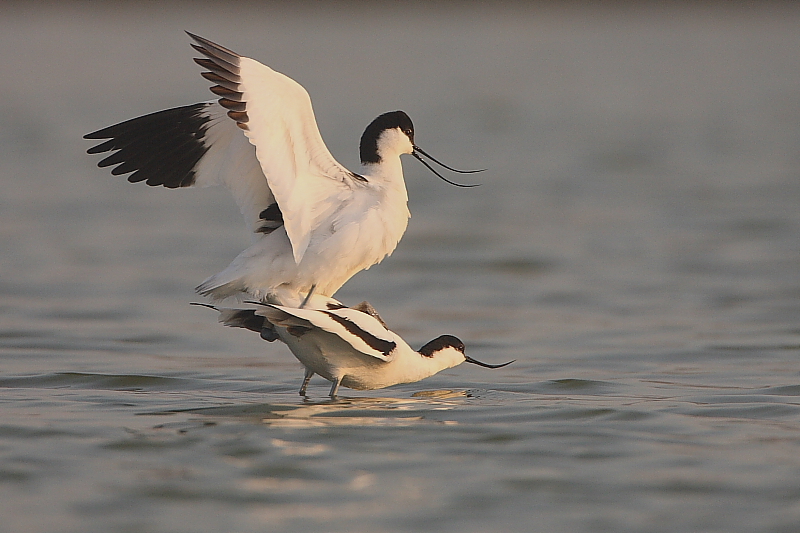
Photo: Pied Avocets are mating on the project site in April 2009 (Photo: János Oláh).
In 2010: We continued the weekly monitoring for the registration of migrating species in 2010 as well. As the result of this ornithological monitoring plus additional ornithological observations on the project site, the total list of observed bird species increased from 194 (end of 2009) to 228 by the end of 2010. This is a great result considering that 267 species were ever observed at this site. In fact we added 35 species to the bird list of the project and two new species to the bird list of the area this year!

Fénykép: Táplálkozó nagy kócsagok a Nagy-sziken 2010 augusztusában (Fotó: Oláh János)
It was interesting that as the result of ecologically sustainable high level of grazing as well as the unusually large amount of precipitation some large number of migrating birds were recorded:
• Great White Egret 318 individuals (22/08/2010)
• Black-winged Stilt 311 individuals (30/07/2010)
• Wood Sendpiper 720 individuals (16/07/2010)
• White-winged Tern 850 individuals (16/07/2010)
Some superindicator species were recorded on the project site again in 2010: Red-breasted Goose, Lesser White-fronted Goose, Pallid Harrier, Imperial Eagle and Collared Pratincole.
The surveying of breeding waterbirds was occured with territorial mapping method just like in the previous year. These results are introduced in the table below. This year no superindicator species were breeding on the project site yet again but it was very interesting how the number of breeding waterbird pairs increased from 66 pairs to 175 pairs! These included Ferrugionus Duck and Corncrake both ‘priority funding’ breeding water birds in the Europian Union.
The total number of breeding waterbirds (pairs) at the different sites of the project area in 2010 |
||||
| Sites | Nagy-szik |
Kerek-fenék |
Magdolna |
Total |
Species |
|
|
|
|
Tachybaptus ruficollis |
16 |
3 |
0 |
19 |
Podiceps nigricollis |
2 |
0 |
0 |
2 |
Podiceps cristatus |
1 |
0 |
0 |
1 |
Botaurus stellaris |
1 |
0 |
0 |
1 |
Ixobrychus minutus |
2 |
0 |
0 |
2 |
Anser anser |
0 |
0 |
0 |
0 |
Anas platyrhynchos |
8 |
5 |
3 |
16 |
Anas querquedula |
1 |
1 |
1 |
3 |
Aythya ferina |
0 |
3 |
0 |
3 |
Aythya nyroca |
1 |
1 |
0 |
2 |
Rallus aquaticus |
2 |
0 |
1 |
3 |
Porzana parva |
3 |
1 |
0 |
4 |
Porzana porzana |
9 |
0 |
0 |
9 |
Crex crex |
0 |
0 |
8 |
8 |
Gallinula chloropus |
12 |
2 |
1 |
15 |
Fulica atra |
37 |
8 |
4 |
49 |
Recurvirostra avosetta |
0 |
0 |
0 |
0 |
Himantopus himantopus |
0 |
3 |
0 |
3 |
Vanellus vanellus |
8 |
11 |
4 |
23 |
Tringa totanus |
4 |
4 |
1 |
9 |
Chlidonias hybrida |
3 |
0 |
0 |
3 |
Total |
110 |
42 |
23 |
175 |
In 2011: The weekly monitoring continued for the registration of migrating species in 2011 as well. As the result of this ornithological monitoring plus additional ornithological observations on the project site, the total list of observed bird species increased from 194 (2009) to 236 (2011). This is a great result considering that 267 species were ever observed at this site ever.
The ecologically sustainable high level of grazing reached the desired level by 2011 and some parts of the soda pan has the appearance both physical and chemical like it was 25 years ago. The birdlife also has changed and although this year was not as wet as 2010 large number of migrating birds were recorded yet again. Interesting observation included Dalmatian Pelican, European Oystercatcher and Citrine Wagtail. Shorebirds were particularly numerous on migration with thousands of Ruffs were seen on the Spring migration and scarce waders also appeared like up to 23 Marsh Sandpipers were seen in spring and several Broad-billed Sandpipers in the autumn. Some superindicator species were recorded on the project site again in 2011:
- Red-breasted Goose: 38 individuals on 6 occasions (maximum 25 in the lake bed)
- Pallid Harrier: 2 observations of 2 individuals
- Imperial Eagle: 3 observations of 3 individuals
- Collared Pratincole: 2 observations of 2 individuals
- Citrine Wagtail: 1 observation of 1 juvenile individual
The surveying of breeding waterbirds was occurred with territorial mapping method just like in the previous years. These results are introduced in the table below. This year no superindicator species were breeding on the project site yet again but it was very interesting to see that the number of breeding waterbirds did not change significantly from 2010 to 2011 despite being a less wet, almost average year. This is mainly the result of the grazing. Interesting events included the two pairs of Avocet has bred at the project site in soda pan habitat after 20 years again (good soda pan indicator)! Black-winged Stilts formed two colonies and a total of 24 pairs have bred. Other interesting breeding birds were Bittern and Ferrugionus Duck.
The total number of breeding waterbirds (pairs) at the different sites of the project area in 2011 |
||||
Sites |
Nagy-szik |
Kerek-fenék |
Magdolna |
Total |
Species |
|
|
|
|
Tachybaptus ruficollis |
1 |
3 |
3 |
7 |
Podiceps nigricollis |
0 |
0 |
0 |
0 |
Podiceps cristatus |
3 |
0 |
0 |
3 |
Botaurus stellaris |
1 |
0 |
1 |
2 |
Ixobrychus minutus |
2 |
0 |
1 |
3 |
Anser anser |
1 |
0 |
0 |
1 |
Anas platyrhynchos |
3 |
8 |
4 |
15 |
Anas querquedula |
0 |
2 |
1 |
3 |
Aythya ferina |
0 |
2 |
2 |
4 |
Aythya nyroca |
0 |
1 |
1 |
2 |
Rallus aquaticus |
3 |
1 |
1 |
5 |
Porzana parva |
1 |
0 |
0 |
1 |
Porzana porzana |
0 |
0 |
0 |
0 |
Crex crex |
0 |
0 |
0 |
0 |
Gallinula chloropus |
8 |
5 |
1 |
14 |
Fulica atra |
9 |
23 |
5 |
37 |
Recurvirostra avosetta |
0 |
2 |
0 |
2 |
Himantopus himantopus |
9 |
15 |
0 |
24 |
Charadrius dubius |
3 |
0 |
0 |
3 |
Vanellus vanellus |
16 |
9 |
4 |
29 |
Tringa totanus |
6 |
5 |
1 |
12 |
Larus ridibundus |
1 |
0 |
0 |
1 |
Chlidonias hybrida |
0 |
0 |
0 |
0 |
Total |
67 |
76 |
25 |
168 |
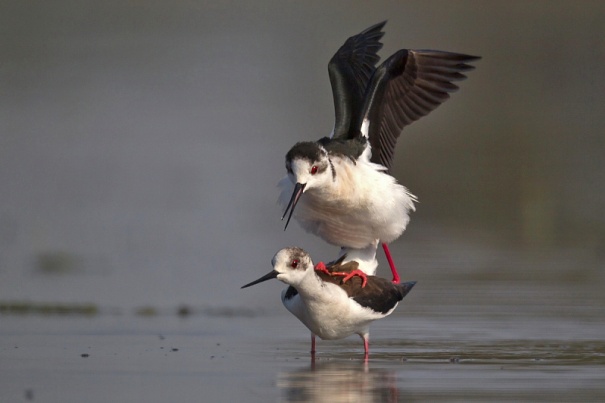
Picture: Black-winged Stilts (Himantopus himantopus) mating at the Kerek-fenék. In 2011 up to 24 pairs have bred in the project area (Photo: Beat Rüegger)
In 2012:The weekly monitoring continued for the registration of migrating species in 2012 as well. As the result of this ornithological monitoring plus additional ornithological observations on the project site, the total list of observed bird species increased from 194 (2009) to 240 (2012). This is a great result considering that 267 species were ever observed at this site ever.
The ecologically sustainable high level of grazing reached the desired level already by 2011 and was maintained throughout 2012.
The birdlife is also changing, continuously adapting to the increasing soda pad appearance. Although 2012 was a very dry year when the Kerek-fenék was dry all year round and even the deepest parts of the Nagy-szik dried out by late June the breeding of several soda pan indicator species was a great event. We had 89 pair of breeding shorebirds of which 34 pairs were Avocets at Nagy-szik where the species has not been breeding for 20 years.
Interesting observation included White Pelican, Wood Lark and Rose-coloured Starling. Scarce waders like Marsh Sandpiper and Red-necked Phalarope also appeared on the soda pan. Some superindicator species were recorded on the project site again in 2012:
- Lesser White-fronted Goose: 2 individuals on 2 occasions
- Red-breasted Goose: 24 individuals on 4 occasions
- Pallid Harrier: 3 observations of 3 individuals
- Imperial Eagle: 4 observations of 4 individuals plus a long-staying adult bird from August to December (when it died; see news: lifeplus_hirek.php
- Kentish Plover: 1 individuals on 1 occasions
- Lapland Bunting: 3 observations of 3 individuals
The surveying of breeding waterbirds was occurred with territorial mapping method just like in the previous years. These results are introduced in the table below.
This year no superindicator species were breeding on the project site yet again but it was very interesting to see that while the number of breeding waterbirds decreased from 2011 – which is not surprising for an extremely dry year – the number of breeding shorebirds still increased (continuous since 2009).
The total number of breeding waterbirds (pairs) at the different sites of the project area in 2012 |
||||
Sites |
Nagy-szik |
Kerek-fenék |
Magdolna |
Total |
Species |
|
|
|
|
Tachybaptus ruficollis |
0 |
0 |
0 |
0 |
Podiceps nigricollis |
0 |
0 |
0 |
0 |
Podiceps cristatus |
0 |
0 |
0 |
0 |
Botaurus stellaris |
1 |
0 |
0 |
1 |
Ixobrychus minutus |
2 |
0 |
0 |
2 |
Anser anser |
0 |
0 |
0 |
0 |
Anas platyrhynchos |
5 |
0 |
2 |
7 |
Anas querquedula |
0 |
0 |
0 |
0 |
Aythya ferina |
0 |
0 |
0 |
0 |
Aythya nyroca |
0 |
0 |
0 |
0 |
Rallus aquaticus |
3 |
0 |
2 |
5 |
Porzana parva |
0 |
0 |
0 |
0 |
Porzana porzana |
0 |
0 |
0 |
0 |
Crex crex |
0 |
0 |
0 |
0 |
Gallinula chloropus |
8 |
0 |
5 |
13 |
Fulica atra |
0 |
0 |
0 |
0 |
Recurvirostra avosetta |
34 |
0 |
0 |
34 |
Himantopus himantopus |
16 |
0 |
0 |
16 |
Charadrius dubius |
4 |
0 |
0 |
4 |
Vanellus vanellus |
16 |
5 |
3 |
24 |
Tringa totanus |
9 |
0 |
0 |
9 |
Limosa limosa |
2 |
0 |
0 |
2 |
Larus ridibundus |
0 |
0 |
0 |
0 |
Chlidonias hybrida |
0 |
0 |
0 |
0 |
|
|
|
|
|
Total |
100 |
5 |
12 |
117 |
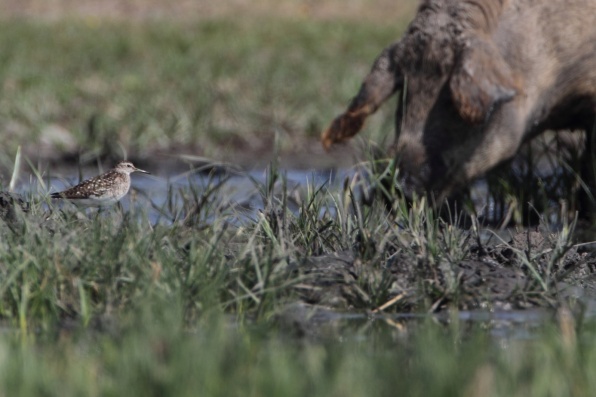
Picture: Wood Sandpipers were very common around the ‘wooly’ mangalica pigs on migration (Photo: János Oláh)
2013: During the project period altogether 242 bird species were observed at the project site, which is over 90% of the total birds ever recorded at the project site.

Figure: Number of recorded bird species in the project area between 2009 and 2013
As a result of the project activities breeding waterbird numbers show a clear increase, though annual fluctuations are affected by annual rainfall.
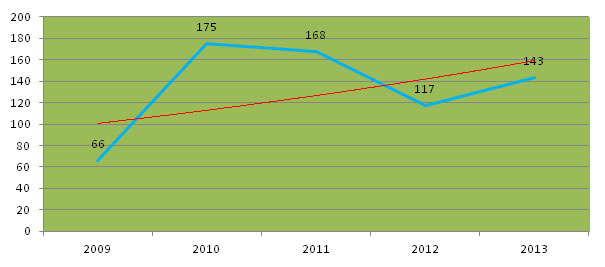
Figure: Number of breeding waterbirds in the project area between 2009 and 2013
The sodic lake characteristic improved significantly that can be seen very well by the increase of the ground nesting shorebird population as the numbers increased every year independently from the annual rainfall.
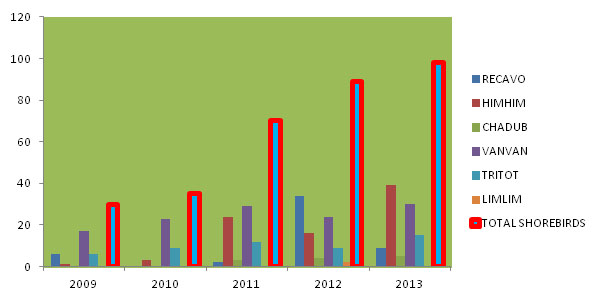
Figure: Number of breeding shorebirds in the project area between 2009 and 2013
Change of migratory shorebird population also support the achievement of the project’s goals, however these numbers are heavily influenced by the rainfall.

Figure: Number of migrating birds in the project area between 2009 and 2013
Besides the improvement of the ecological status disturbance also ceased that can be measured by the increase of the number of geese species and cranes. The presence of ranger service was stepped up; uncontrolled access fell to insignificant levels that led to the increase of the above number of the above species.

Figure: Number of migrating Anser sp and Grus grus between 2009 and 2013
